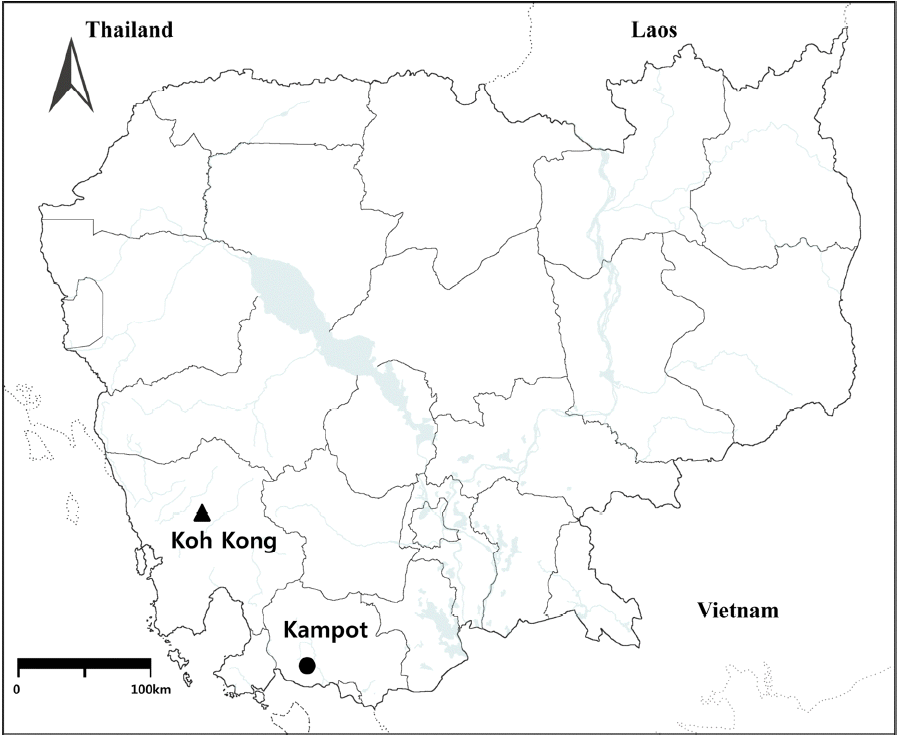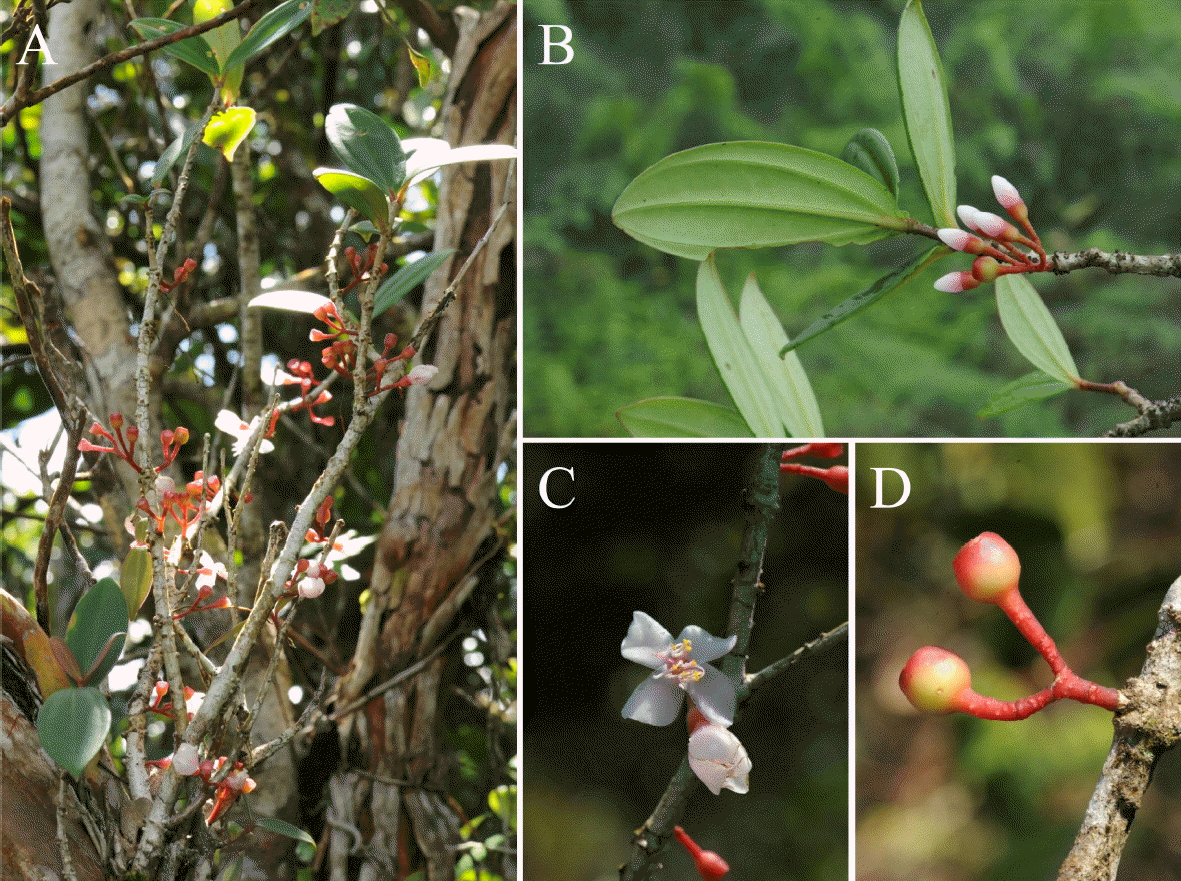캄보디아 미기록 식물 Medinilla속 2종
Two newly recorded species of the genus Medinilla from Cambodia
Article information
Abstract
야목단과 Medinilla속의 두 종, M. rubicunda, M. septentrionalis를 캄보디아의 Bokor 국립공원과 Central Cardamom 보호림에서 발견하여 캄보디아 미기록종으로 보고하였다. Medinilla rubicunda는 인도네시아(수마트라, 자바)와 태국에 분포하는 M. laurifolia에 비해 엽병과 화서가 짧고, 6개 이하의 꽃이 달리며, M. septentrionalis는 베트남과 중국(운남성)에 분포하는 M. nana에 비해 소지가 원통형이고, 수피는 얇으며 코르크가 발달하지 않는다. 본 논문에서는 캄보디아에 새롭게 발견된 Medinilla속 2종의 기재, 사진과 함께 캄보디아 Medinilla속의 검색표를 제시하였다.
Trans Abstract
Two newly recorded species of Melastomataceae, Medinilla rubicunda and M. septentrionalis, were found from the Phnom Bokor National Park and the Central Cardamom Protected Forest in Cambodia. Medinilla rubicunda is similar to M. laurifolia from Indonesia (Sumatra and Java) and Thailand, but is readily distinguished from the latter by its shorter petiole and a cyme bearing fewer than six flowers. Medinilla septentrionalis is similar to M. nana from China (Yunnan) and Vietnam, but is clearly distinguished from the latter by its terete branchlets, which have a thin and not a corky bark. Descriptions, photographs, and a diagnostic key of the three species of Cambodian Medinilla are provided for species identification.
Melastomataceae Juss. consist of approximately 166 genera and 4,200–4,500 species which are distributed in both the New World (about 2,950 species) and the Old World (1,275–1,550 species). In Cambodia, Melastomataceae are currently represented by 32 species in 9 genera (Guillaumin, 1913; Dy Phon, 2000; Renner et al., 2001). The most species-rich genera in Cambodia are Memecylon L. (13 species) and Osbeckia L. (7 species), whereas Sonerila Roxb. is represented by 2 species. Blastus Lour., Medinilla Gaudich., Ochthocharis Blume, Oxyspora DC., and Pternandra Jack are each represented by only one species.
Medinilla is the second largest genus in Melastomataceae, with approximately 375 (Mabberley, 2008) to 400 species (Willis, 1973), and includes epiphytic and terrestrial shrubs and climbers. Most species of Medinilla have ornamental value, on account of their evergreen leaves, attractive panicles, and long-lasting fruits. Consequently some species, including M. crassata Elmer, M. magnifica Lindl., and M. scortechinii King, have been widely cultivated in tropical and subtropical regions (Madulid, 1995; Rosario and Mendoza, 1998; Wang et al., 2015).
Medinilla has two centers of biodiversity, Africa and Asia. In Asia, the genus is distributed in India, Sri Lanka, Myanmar, Indochina, southern China, Thailand, the Malay Peninsula, and eastward to the islands of the Malay Archipelago, New Guinea, northern Australia, Micronesia, and Melanesia (Regalado, 1990). Most of the species of Medinilla in Asia (ca. 200), are distributed in Malesiana (Regalado, 1990). At present, the genus is represented by 80 species (72 endemic) in the Philippines (Regalado, 1995), 48 (40 endemic) in Borneo (Regalado, 1990), 25 (10 endemic) in Sumatra (van den Brink Bakhuizen, 1945), 16 (3 endemic) in Sulawesi (van den Brink Bakhuizen, 1945), 15 (5 endemic) in Peninsular Malaysia (Maxwell, 1978), and 13 (1 endemic) in Java (van den Brink Bakhuizen, 1945). Sixteen species of Medinilla are distributed in Indochina, of which 11 (5 endemic) species are found in Vietnam (Ho, 1999; Nguyen, 1995), 5 in Thailand (Craib, 1931; Maxwell, 1978; Renner et al., 2001), 2 in Laos (Newman et al., 2007) and 1 in Cambodia (Guillaumin, 1913).
Prior to the present study, M. radicans Blume was the only known species of Medinilla in Cambodia, reported from the Phnom Bokor National Park in Kampot province (Guillaumin, 1913). However, during our recent extensive floristic survey, two further species of the genus Medinilla were collected from Kampot and Koh Kong provinces, respectively (Fig. 1). These two species were identified as Medinilla rubicunda (Jack) Blume and Medinilla septentrionalis (W. W. Smith) H. L. Li based on reference to the Flore Generale de l’Indo-Chine (Guillaumin, 1913), the Flora of China (Chen and Renner, 2007) and Flora of Thailand (Renner et al., 2001). These two species are new to the flora of Cambodia, and herein, we report the new distribution records of the two species and provide a diagnostic key, descriptions, and photographs.

Distribution of Medinilla rubicunda (Jack) Blume (•) and M. septentrionalis (W. W. Sm.) H. L. Li (▴) in Cambodia.
Taxonomic Treatment
1. Medinilla rubicunda (Jack) Blume, Flora 14: 512, 1831; Melastoma rubicundum Jack, Trans. Linn. Soc. London 14: 18, 1823 (Fig. 2).
Medinilla erythrophylla Wall. ex Lindl., Edwards’s Bot. Reg. 24: 85, 1838.
Medinilla emarginata W. G. Craib, Bull. Misc. Inform. Kew 1930: 322, 1930.
Medinilla hainanensis Merr. & Chun, Sunyatsenia 2: 292, 1935.
Medinilla yunnanensis H. L. Li, J. Arnold Arbor. 25: 39, 1944.
Medinilla fuligineoglandulifera C. Chen, Acta Phytotax. Sin. 21: 420, 1983.
Medinilla rubicunda var. tibetica C. Chen, Acta Phytotax. Sin. 21: 420, 1983.
Shrubs, sometimes epiphytic 0.5–1.5 m tall, many-branched. Stems light brown or tan, obtusely 4-angled, later terete, smooth or scattered lenticellate, glabrous; bark wrinkled. Leaves opposite; petioles 2.0–2.5 mm, glabrous; leaf blade elliptic to ovate-lanceolate, 6–15 × 2.5–5.5 cm, succulent to subleathery, both surfaces glabrous, abaxially slightly tuberculate, secondary veins 1 on each side of midvein, base broadly cuneate, margin entire, apex acute. Inflorescences at leaf scars on older branches, cymose, 2.5–3.0 cm long, 3–5(6)-flowered; peduncle to 3 mm, puberulous. Flowers 4-merous; pedicel 2.5–3.5 mm, puberulous; bracteoles 2 at base of each pedicel, acutely triangular, ca. 0.5 mm long; hypanthium funnel-shaped, 4.5– 5.0 mm long, puberulous; calyx lobes inconspicuous; petals pale pink, rhomboid-obovate, ca 7 × 6 mm, apex rounded, glabrous; stamens 8, equal, ca. 1 cm long; anthers lanceolate, ca. 6.5 mm, curved; connective ventrally, slightly bilobed, adaxially 2-tuberculate. Fruit berry, subglobose to urceolate, 8–10 × 5–6 mm. Seeds numerous, obovate, glabrous.
Phenology: Flowering in July to August; fruiting in September to October.
Distribution: Bhutan, Southern China, Northeastern India, Malay Peninsula, Northern Myanmar, Nepal, Thailand. Cambodia, found in the Phnom Bokor National Park, Kampot province.
Specimens examined: CAMBODIA. Kampot: Phnom Bokor National Park, 10°38′ 20.8″ N, 104°00′ 16.0″ E, elev. 1,051 m, 24 Aug 2015, Cho et al. CB-3111 (HHU), 10°37′ 07.9″ N, 104°01′ 55.0″ E, elev. 1,057 m, 27 Aug 2015, Cho et al. 3182 (HHU), 10°39′ 04.8″ N, 104°01′ 47.1″ E, elev. 920 m, 28 Aug 2015, Cho et al. 3194 (HHU, KB).
Medinilla rubicunda has been reported from Bhutan, southern China, Northeastern India, Malay Peninsula, Northern Myanmar, Nepal, and Thailand, but previously never from Cambodia (Renner et al., 2001; Chen and Renner, 2007). In Cambodia, this species was discovered in upper montane forest, up to ca. 900 m elevation, in Phnom Bokor National Park. The species was found growing in dwarf forests dominated by Dacrydium elatum (Roxb.) Wall. ex Hook., Lithocarpus elephantum (Hance) A. Camus, and Lithocarpus leiophyllus A. Camus. It was found growing epiphytic on a 3–5 m tall tree with a stem diameter of 20 cm. M. rubicunda is similar to M. laurifolia Blume from Thailand, Sumatra, and Java, but it is readily distinguished from the latter by its shorter petiole (2.0–2.5 mm long) and cyme (2.5–3.0 cm long) bearing fewer than 6 flowers.
2. Medinilla septentrionalis (W. W. Sm.) H. L. Li, J. Arnold Arbor. 25: 38, 1944; Oritrephes septentrionalis W. W. Sm., J. Proc. Asiat. Soc. Bengal 7: 69, 1911; Pseudodissochaeta septentrionalis (W. W. Sm.) M. P. Nayar, J. Bombay Nat. Hist. Soc. 65: 565, 1969 (Fig. 3).
Medinilla caerulescens Guillaumin, Fl. Gen. Indo-Chine, 2: 921, 1921.
Anplectrum yunnanense Kraenzl., Vierteljahrsschr. Naturf. Ges. Zurich 76: 153, 1931.
Medinilla caerulescens var. nuda Craib, Fl. Siam. Enum. 1: 699, 1931.
Shrubs 1–3 m tall, many branched, erect. Branches terete, glabrous, slightly scattered lenticellate. Leaves opposite; petioles 4–8 mm; leaf blade lanceolate, ovate-lanceolate, 7–8 × 2–3 cm, papery, both surfaces glabrous or sometimes adaxially setose between midvein and secondary veins, secondary veins 2 on each side of midvein, base obtuse to rounded, margin serrulate apically from 2/3, apex acuminate. Inflorescences axillary, cymose, 2–5 cm long, (1)3–5-flowered, glabrous; peduncle 1–2 cm. Flowers 4-merous; hypanthium campanulate, ca. 5 mm long, glabrous; calyx shallowly 4-lobed, apiculate; petals pink, triangular-ovate, ca. 6 mm long, apex acute; stamens 8, subequal; longer stamens ca. 13 mm long; shorter stamens ca. 11 mm long. Connective ventrally, slightly bilobed; ovary ovoid, apex 4-undulate. Fruit berry, ovoid to urceolate, ca. 7 ×6mm. Seeds numerous, cuneate, densely tuberculate.
Phenology: Flowering in November to December; fruiting in January to February.
Distribution: Southern China, Laos, Myanmar, Northern Thailand, and Vietnam. Cambodia, found in the Central Cardamom Protected Forest of Koh Kong province.
Specimens examined: CAMBODIA. Koh Kong: Central Cardamom Protected Forest, 11°51′ 25.3″ N, 103°34′ 09.1″ E, elev. 622 m, 9 Jan 2012, Won et al. 6590 (HHU, DGU), 11°50′ 18.3″ N, 103°34′ 49.8″ E, elev. 720 m, 10 Jan 2012, Won et al. 6656 (HHU, DGU).
Medinilla septentrionalis has been reported in southern China, Laos, Myanmar, Northern Thailand, and Vietnam, but previously never in Cambodia. In the Flora of Thailand, M. septentrionalis has been treated as Pseudodissochaeta septentrionalis (W. W. Sm.) M. P. Nayar (Renner et al., 2001). However, in a more recent classification in the Flora of China, Chen and Renner (2007) treated genus Pseudodissochaeta as a synonym of genus Medinilla. In Cambodia, this species was discovered in Malesian rainforest in the Central Cardamom Protected Forest. Medinilla septentrionalis is similar to M. nana S. Y. Hu from China (Yunnan), Vietnam, but it is readily distinguished from the latter by its terete branchlets, which have a thin and not a corky bark.
A key to Medinilla species in Cambodia
1. Leaves 4–5-verticillate ································· M. radicans
1. Leaves opposite.
2. Leaves and branchlets succulent, peduncle to 3 mm ·································································· M. rubicunda
2. Leaves and branchlets not succulent, peduncle 1–2 cm ·························································· M. septentrionalis
Acknowledgements
This work was supported by a grant from the National Institute of Biological Resources (NIBR), the Ministry of Environment (MOE) of the Republic of Korea (NIBR2016 04201).

